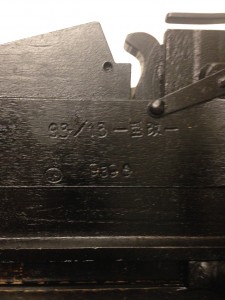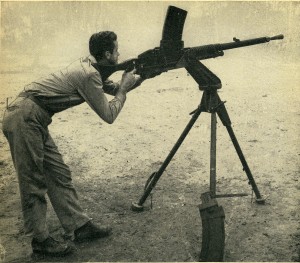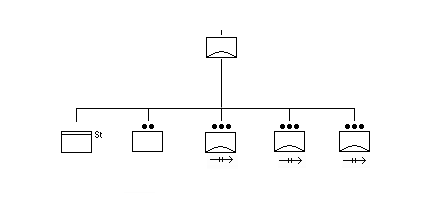Mysterious gun
Marc Lohnstein, assistant-curator
In 1950 the Royal Netherlands Indonesian Army (KNIL) send a large shipment of captured Japanese equipment, instruments and arms from Indonesia to the Netherlands. The shipment was destined for Museum Bronbeek in Arnhem.
Part of this shipment of 38 crates was a weapon listed as “Anti-tank buksen 13mm. 1 stuks. [9366]” (antitank rifle 13 mm 1 item). In the museum database the weapon was registered as a Japanese light machine gun or as the model 98 (1938) 20 mm antiaircraft antitank automatic canon. Three descriptions for one weapon.

AA HMG 13 mm Model 93. Collection Museum Bronbeek
According to new research the descriptions are found to be incorrect. Based on markings and photographical evidence the weapon is identified as the Type 93 (1933) 13 mm antiaircraft heavy machine gun of the Japanese Imperial Navy.
Additional information is needed, since it is marked as a modified version.
Description
The weapon in the collection is not complete. It consists of the barrel with flash nozzle, receiver, trigger group and shoulder butt. The mount and the magazine are missing. This counts also for parts of the firing mechanism.
The weapon has several markings. On the right side of the receiver the markings are:
93/13 – 改番 –
circle 9398

Markings on the receiver
The numbers 93/13 stands for the type and calibre.
The Japanese characters 改番 mean “kaigata” or remodeled. This implies that the weapon is a modification.
The circle mark contains (ト) the Kanji symbol for “toh” or “number 5”. The meaning of this mark is unknown.
The serial number is 9398.
Technical information
The Type 93 is a gas-operated, air-cooled, magazine fed, full-automatic weapon. The magazine is curved and top-mounted. The design of the Type 93 is based on the French mitrailleuse Hotchkiss de 13,2 mm modèle 1929 or in English 13.2 mm Hotchkiss heavy machine gun model 1929.
Technical specifications:
Type Machine Gun
Caliber 13.2 mm
Mechanism gas-operated, full-automatic
Cooling air-cooled
Length 1,670 mm
Barrel length 1,000 mm
Weight 37.5 kg
Fed magazine
Magazine capacity 30 rounds
Ammunition ball, tracer and armor-piercing
Ammunition Weight 0.05 kg
Rate of Fire 450 rounds/min
Muzzle velocity 800 m/s
Elevation -15° to +85°
Traverse 360°
Maximum range horizontal 6.000 m
Maximum range vertical 3.500 m
Maximum effective range 1.500 m
Sights Front: blade
Rear : folding leaf graduated 300 to 3.600 meter.
The weapon was mounted as a single barrel on a tripod or naval pedestal mount and as twin and quad mount. The technical specifications are mainly based on the US Naval Technical Mission to Japan report.

American with a Type 93 on tripod. Handbook Japanese Military Forces.
Production
The Imperial Japanese Navy introduced the Hotchkiss in 1933. The navy started in 1935 machine gun production itself in order to become independent of imports. Towards the end of the war production figures reached 1.200 per month. The Type 93 was produced by the Yokosuka Navy Yard. The Japanese Army also used this weapon. The Army designation was Type Ho. The Type 93 was designed as an antiaircraft gun, but was also often used against ground targets.
About the effectiveness of the Type 93 the opinions are somewhat divided. According to some the heavy mounts made the weapon unwieldy, the round was too light to effectively combat allied aircraft, barrel change took five minutes and the magazine feed reduced the effective rate of fire to about 250 rounds per minute. Others are of the opinion that the Type 93 was capable of a sustained rate of fire if manned by a well trained crew that changed magazines real fast.
Japanese naval antiaircraft ground defence units
Is it possible to identify the unit the museum artifact belonged to?
According to the U.S. military intelligence the Imperial Japanese Navy had at the end of the war stationed four antiaircraft units (防空隊 = Bokutai) in Surabaya. This was the main naval base in Indonesia of the 2nd Southern Expeditionary Fleet. The identified units are:
103th AA Defence Unit
108th AA Defence Unit
109th AA Defence Unit
113th AA Defence Unit.
The four AA Defense Units are not listed according to type. The Imperial Japanse Navy distinguished between three types of antiaircraft units. Type A was armed with antiaircraft artillery and machine-guns, Type B with machine-guns only, and Type C with machine-guns and machine-cannon. According to the American intelligence the Type B was the only one equipped with the 13 mm machine gun. This company-size unit consists of a command, observation unit and three machine gun platoons. Total strengths was 225 men with:
13 mm machine gun 32
7.7 mm machine gun 10
search lights 2.

Order of Battle Bokutai
The allotment of the weapons within the unit was not known.
By the end of 1945 large amounts of Japanese weapons were seized by Indonesian militia. These weapons were employed in the Indonesian war of independence.
With thanks to dr. Kaori Maekawa.
Sources
- Handbook on Japanese Military Forces, Technical Manual TM-E 30-480, War Department 1 October 1944.
- ホ式十三粍高射機関砲. See https://ja.wikipedia.org/wiki/ホ式十三粍高射機関砲
- Japanese Naval Ground Units “Know your enemy!” CinCPAC – CinCPOA – Bulletin 11-45. See http://www.ibiblio.org/hyperwar/USN/ref/KYE/CINCPAC-11-45/
- Japanese 13/76 Antiaircraft Gun. See http://pwencycl.kgbudge.co/J/a/Japanese_13mm_76_AA_gun.htm
- Rottman, Gordon L., Japanese Army in World War War II. The South Pacific and New Guinea, 1942-43. Osprey Publishing 2005.
- Japanese Navy Type 93 or Japanese Army Type Ho. See http://www.ww2incolor.com/japan/weapon_hotchkiss132_2.html
- Japan 13 mm/76 (0.52″) Type 93. See http://www.navweaps.com/Weapons/WNJAP_13mm-76_mg
- US Naval Technical Mission to Japan report. Target Report – Japanese Naval Guns and Mounts, Article 2 – AA Machine Guns and Mounts. Intelligence Targets Japan (DNI) of 4 Sept. 1945. Fascicle O-1, Targets O-46 (N) and O-47 (N). February 1946. See http://www.fischer-tropsch.org/primary_documents/gvt_reports/USNAVY/USNTMJ%20Reports/USNTMJ_toc.htm
